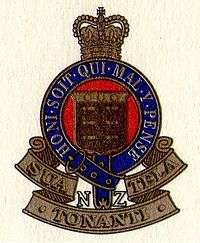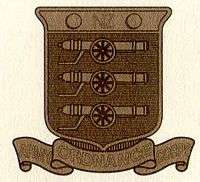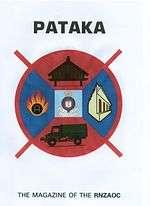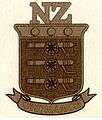Royal New Zealand Army Ordnance Corps
| Royal New Zealand Army Ordnance Corps | |
|---|---|
 | |
| Active | 1915–1996 |
| Country |
|
| Branch |
|
| Role | Storage and issuing of ordnance |
| Motto(s) | Sua tela tonanti commonly translated as "To the Warrior his Arms" |
| Colours | Scarlet and dark blue |
| March | The Village Blacksmith |
| Anniversaries | 12 July |
| Commanders | |
| Colonel-in-Chief | Queen Elizabeth II |
The Royal New Zealand Army Ordnance Corps (RNZAOC) was a Logistic corps of the New Zealand Army. From a genesis with the Colonial Storekeeper in the 1840s, it grew over the next 100 years into a Royal Corps with responsibility for weapons, vehicles and other military equipment, ammunition, clothing and certain minor functions such as laundry and mobile baths. The RNZAOC was also responsible for a major element of the repair of Army equipment. In 1946 the latter function was transferred to the New Zealand Electrical and Mechanical Engineers. The RNZAOC retained repair responsibilities for ammunition, clothing and certain ranges of general stores. In 1979 the RNZAOC absorbed petroleum and rations functions from the Royal New Zealand Army Service Corps.[1] On 8 December 1996, the RNZAOC was one of the corps that amalgamated to form The Royal New Zealand Army Logistic Regiment (RNZALR).[2][3]
History
Military Stores Department
The RNZAOC traces its origins back to the early days of the New Zealand Colony. Military stores to support the Imperial troops and colonial militia units were provided by the British Board of Ordnance based out of Sydney New South Wales, with local support between 1840 and 1844 provided by the Colonial Storekeeper.
In the years following the Crimean War the Board of Ordnance was abolished and its responsibility’s taken over by the Military Stores Department.[4] In 1856 stores depots were established at Mt Cook in Wellington and at Fort Britomart in Auckland, by 1870 the final withdrawal of Imperial troops had been completed.
Defence Stores Department
By the time of the final withdrawal of Imperial troops by 1870 the full responsibility for providing stores for the New Zealand forces had gradually been assumed by the New Zealand Defence Stores Department.[5] In the early years of the 20th Century, it was recognised that New Zealand Defence stores functions, which were controlled by a combination of civilian and military departments were in need of rationalisation and modernisation. Various studies were undertaken and many recommendations made, with organisational changes taking plave in 1907 and after then 1910 inspection and recommendations of Field Marshal Viscount Kitchener plans for the formation of an Ordnance Corps progressed slowly with small steps taken in 1911, the ad hoc formation of the NZAOC within the NZEF and finally the formation of the New Zealand Army Ordnance Department and Corps with them being Gazetted in 1 Feb 1917 taking over the functions of the Defence Stores.
Royal New Zealand Artillery
In 1907 the Defence Forces underwent a command reorganisation with the creation of the Defence Council. Separate of the Defence Stores Department, but still under the Defence Council, the position of the Director of Artillery Services (Ordnance) was created[6]
The Director of Artillery Services (Ordnance) was responsible for Artillery armament and ammunition, fixed coast defences, and supplies for ordnance, and it was envisaged that it would be constituted of three sub branches:
- Ordnance branch - Responsible for Artillery armament and fixed coast defences
- Stores Branch - All supplies for the Artillery
- Director of Artillery Branch- Personnel Management of the Artillery
The Defence report of 1914 identified that the Artillery Departments of Ordnance was to be absorbed into the Quartermaster General branch and that the officer who had held the appointment of Director of Ordnance will become Chief Instructor of Garrison Artillery and Inspector of all Artillery, coast defences, fortifications, guns, and ammunition and all Ordnance stores functions handed over to the Director of Equipment and Stores.
- Director of Artillery Services (Ordnance)
| Rank | Name | Start date | Finish Date | Notes |
|---|---|---|---|---|
| Major | G.N Johnston | 23 Feb 1907 | 31 May 1907 | Director of Artillery Services (Ordnance) |
| Captain | G.S Richardson | 31 May 1907 | Director of Ordnance | |
| Lt Col | H.F Head | 31 July 1908 | 31 Mar 1911 | Director of Ordnance |
| Major | Hume | 31 Mar 1911 | Director of Ordnance | |
| Lt Col | G.N Johnston | 15 Mar 1911 | 1914 | Director of Ordnance & Artillery |
- New Zealand Army Ordnance Section
As a result of shortfalls caused by the 1914-19 war, it was decided to create an Ordnance section to inspect and manufacture artillery ammunition and on 1 April 1915, the Army Ordnance Section of the NZ Army was created.[7][8][9][10]
By 1919 most of the Ordnance Stores functions carried out by the Royal New Zealand Artillery had been assumed by the New Zealand Army Ordnance Corps(NZAOC) and New Zealand Army Ordnance Department(NZAOD), but it was not until 1929 that Artillery Artificers were transferred to the NZAOC.[11]
New Zealand Army Ordnance Department
The New Zealand Army Ordnance Department gazetted on 1 February 1917, consisted of Officers who would command the New Zealand Army Ordnance Corps, which comprised the Warrant Officers, NCOs and men.[12]
New Zealand Army Ordnance Corps
Between 1914 and 1947 the New Zealand Army Ordnance Corps(NZAOC) existed in three distinct iterations;
- NZAOC as part of the NZEF, 1914 - 1920
- NZAOC alongside the NZAOD, 1917-1924
- NZAOC 1924-1947
New Zealand Ordnance Corps
From 1939 Ordnance units in the newly constituted 2NZEF were referred to as the 2NZEF NZOC (New Zealand Ordnance Corps)[13] and was made up of members of the regular Force NZAOC, Territorial force and recently recruited civilians.
With the massive expansion of the Home army in 1940, the New Zealand Ordnance Corps (NZOC) was formally constituted as a stand alone Corps in December 1940. The NZOC was the Ordnance element of the New Zealand Territorial Army,[14][15]and was tasked with home defence and as a feeder for the Expeditionary Forces.[16]
In 1947 a Reorganization of New Zealand Military Forces removed the distinction between Regular and non-Regular soldiers, and the NZOC ceased to be a separate Corps, becoming part of the NZAOC.[17][18]
Royal New Zealand Army Ordnance Corps
The corps was granted the right to use the "Royal" prefix on 12 July 1947.[19]
In 1962, RNZAOC Stores Sections carrying specialised spares, assemblies and workshops materials to suit the particular requirement of its parent RNZEME workshops were approved and RNZEME Technical Stores personnel employed in these were transferred to the RNZAOC.[20]
On 12 May 1979 the Royal New Zealand Army Service Corps ceased to exist and the responsibilities of road, transport, air dispatch and postal functions were handed over to the Royal New Zealand Corps of Transport (RNZCT) who were formed on On 12 May 1979. The responsibilities of provision of foodstuffs and POL (petrol oil lubricants) was handed over to the RNZAOC).
Disestablishment and amalgamation
On 9 December 1996 the corps ceased to exist as it was absorbed into the Royal New Zealand Army Logistic Regiment.
Units and locations
From a genesis of four Stores Depots at the beginning of the 20th century, the RNZAOC expanded and retracted to meet the operational needs of the NZ Army. Wherever New Zealand troops have deployed overseas there has either been a NZ Ordnance unit in support or NZ Ordnance personnel embedded in allied organisations.
Stores accounting
In the early years of the Corps, stores accounting relied upon manually raised vouchers and entries into ledger books and cards. This was detailed work and required much attention to detail and over the years the Corps would be criticized for lax accounting procedures.[21]
As a major part of the Corps activity centered around procurement, provisioning and stores accounting, moves were taken in the mid 1960s to replace stubby pencils and rubbers with the introduction of NCR accounting Machines. The MD310 Ledger card would be the accountable record of the item held in stock. When transactions occurred, the card would be removed from its bin in the ledger office, sent to the machine room, updated on NCR-33 and later NCR-299 machines,[22] once complete the card would be returned to the Ledger office. This was a standalone process with no external outputs. In the early 1970s a ICL computer system was introduced, this provided a paper tape from the accounting machine which would then be uploaded daily in to a mainframe to provide provisioning and reporting data.[23]
In 1981 the NCR machines were still in use but becoming tired and needing replacement. The ICL System was replaced with a Sperry Mainframe and planning started on the Defence Supply System Retail (DSSR), which would be introduced in 1984-85 and the NCR machines retied after just over 20 tears of service.[24] In a few years DSSR was superseded by the Defence Supply System Detail (DSSD), which itself was replaced by the SAP R/3 system in late 1996.
As the NZ Army had a long relation ship with the British Army, the Corps used the Vocabulary of Army Ordnance Stores (VAOS) system of codification of item part numbers, but as the relationship with he United States became closer and more US equipment was coming into service it was decided in 1968 to adopt the NATO Codification System and replace the VAOS number with internationally standardised NATO Stock Number (NSN). With the sponsorship of the United Kingdom, New Zealand was subsequently admitted into the NATO Codification community in 1969. The first official “98” NATO Stock Number was assigned in Dec 1972. With a large number of stores items to be codified a large number VAOS codes were to remain in circulation for many years and systems were put in place to merge the two systems and by the end of the 1970s the NSNs were fully integrated as part of the New Zealand Army supply system.[25][26]
Customs and traditions
Corps Colours
The colours of the New Zealand Army Ordnance Corps were scarlet, in reference to their link with the combat Corps, and dark blue.[27][28]
Flags
RNZAOC Flag
The RNZAOC Flag was 6ft X 3ft divided into three hoizontal panels. The upper and lower panels were 9inch high and post office red in colour. The Center panel was 1ft 6in high and purple navy in colour. The Corps badge was positioned centrally on the flag.[28]
-

RNZAOC Flag 1955-1996
RNZAOC Unit Flag
RNZAOC Unit flags were a 3ft X 2ft at the hoist purple navy pennant, superimposed with a post office red ball.[28]
-

RNZAOC Unit flag 1955-1996
Corps Motto
The RNZAOC's motto was Sua tela tonanti (literally "His [i.e. Jupiter's] Missiles to the one who is Thundering", but commonly translated as "To the Warrior his Arms").[28]
Corps march
The Village Blacksmith adopted by the RAOC as its Corps march in 1922, was by default also adopted as the Corps march of the RNZAOC.[29][28]
Corps Day
the RNZAOC celebrated its Corps day on the 12th of July, which was the anniversery of teh day the RNZAOC was granted the "Royal" prefix.
Patron Saint
The patron saint if the the RNZAOC is Saint Barbara. St Barbara is the patron saint of workers with explosives, artilleryman and miners. St Barbara's day is commemorated on the 4th of December.
Alliances
At the end of 1920 King George V approved an alliance between the RAOC and the Ordnance Corps of Australia, Canada, New Zealand and South Africa. Formal approval was granted in New Zealand on 1 March 1921 by General order 95.[30]
 United Kingdom – Royal Army Ordnance Corps
United Kingdom – Royal Army Ordnance Corps Australia – Royal Australian Army Ordnance Corps
Australia – Royal Australian Army Ordnance Corps Canada – Royal Canadian Ordnance Corps
Canada – Royal Canadian Ordnance Corps.svg.png) South Africa-South African Ordnance Corps
South Africa-South African Ordnance Corps
RNZAOC Uniforms and Dress
Badge
The RNZAOC badge design has evolved as the Corps has grown.[31][32]
The badge worn by the NZ Army Ordnance Section was the RNZA Badge of the time with the word "UBIQUE" replaced by the initials "NZ".
Subsequent badges since 1914 have followed the pattern of the badges of the RAOC culminating in a badge with the following four elements:
- the Crown,
- Garter, The motto of the British Order of the Garter 'Honi soit qui mal y pense' is inscribed on the Garter. The motto can be translated from middle French as either 'Evil to he who evil thinks' or similarly 'shame upon him who evil thinks'.
- Riband, The Riband below the letters NZ is inscribed the Corps Motto "Sua Tela Tonanti" commonly translated as "To the Warrior his Arms".
- Shield. The shield depicts three field cannons facing left and three cannonballs and forms part of the Coat of Arms granted to the Board of Ordnance in 1823. On all cap badges the Cannon face to the left, with the exception of the first pattern NZAOC badge where the cannons face to the right.
Collar badges were miniatures of the cap badge, coming in pairs with the cannons facing both left and right. Beteen 1917-1923 the NZAOC and NZAOD used the same collar badge.
-

NZAOD Badge
1917-1923 -

1st Pattern NZAOC Badge
1917-1923 -

3rd Pattern NZAOC Badge
1937-1947 -

1st Pattern RNZAOC Badge
1947-1955 -

2nd Pattern RNZAOC Badge
1955-1996
- ^ "HE UNOFFICIAL HISTORY OF THE NEW ZEALAND ORDNANCE CORPS IN THE PACIFIC 1940-44". nzetc.victoria.ac.nz/. Retrieved 1 Nov 2016.
- ^ Cite error: The named reference
NZ_Uniformswas invoked but never defined (see the help page).
Stable Belt
The RNZAOC Stable belt was approved for use in 1972.[33] The Belt was based on the RAOC belt having four wide blue stripes with 3 narrow red stripes, the buckle departed form the RAOC patterns, having a 7x6cm chromed buckle on which a RNZAOC Badge was mounted.[28]
-

RNZAOC Stable belt 1972-1996
Shoulder Flashes
Three types of shoulder flashs have been worn[28]
- NZAOD Brass type 1917-1923
- NZAOC Brass type 1917-1945
- NZOC Brass type 1940-1944
- RNZAOC woven type 1955-1996
-

Brass NZAOC Sholder tab 1917-1945
-

RNZAOC Shoulder Flash 1955-1996
Puggaree
The "lemon squeezer" was worn from World War I, to a certain extent during World War II and up to 1960, although often replaced by more convenient forage caps or berets. As a means of unit identification coloured Puggarees were introduced. Puggarees are the The hat band on the felt slouch and Lemon Squeezer hats used by the NZ Army. Puggarees from an Indian (Hindi) word 'paggari' or 'pagri' roughly translated means a small turban. Puggarees on western military headgear have their origins with the British Indian Army's attempt to make the band on helmets and hats look like a stylised turban. New Zealand adopted various coloured Puggarees for different regiments and corps, with Red-Blue-Red being the Colours for Ordnance.[34][28]

Conductors

The appointment of conductor was used in the New Zealand Army up to the 1930s. It then lapsed to be introduced back into the New Zealand Army in 1977, with he proviso that maximum of five conductors can be appointed at any one time. The Appointment of conductor was discontinued with the disestablishment of the Royal New Zealand Army Ordnance Corps (RNZAOC) and the establishment of the Royal New Zealand Army Logistic Regiment(RNZALR) in 1996.[35]
The Henry Tucker club
A tradition maintained by the RNZAOC was the Henry Tucker Club. This was a semi-formal club consisting of senior NCOs, warrant officers and officers that would meet on regular occasions to discuss corps- and trade-related issues. The club was named after Henry Tucker, who was the Colony of New Zealand's first Colonial Storekeeper.[36]
Billy Beck Club
Unlike other RNZAOC units, a Henry Tucker Club did not exist in the New Zealand Advanced Ordnance Depot in Singapore, as the depot was over the water and there was no real affiliation with the first colonial Storekeeper. As Billy Beck was the first New Zealand ordnance soldier to set foot on a foreign land operationally, his name was chosen for the club for all RNZAOC military members posted to Singapore.[37][38]
Pataka magazine

The requirement for a Corps newsletter was first mooted by the Director of Ordnance Services (DOS) in 1968 as a medium to distribute information about activities in the RNZAOC and it was to be published quarterly or more frequently. The first printed edition was published in October 1968 and distributed across the Corps including copies to soldiers then serving in Malaysia and Vietnam.[39]
Later on the name Pataka was adopted as the name of the RNZAOC magazine and issues continued to be produced on a more or less regular basis until the disestablishment of the RNZAOC in 1996.
Memorials
-

RNZAOC Window in Saint Marks Garrison Chapel of Waiouru Military Camp
-

Corps tablet in the Hall of Memories at the Pukeahu National War Memorial Park in Wellington
The RNZAOC has two memorials of note:
- Corps tablet in the Hall of Memories at the Pukeahu National War Memorial Park in Wellington[40]
- RNZAOC Window in Saint Marks Garrison Chapel of Waiouru Military Camp. This window was dedicated in July 1994[41]
RNZAOC painting

Commissioned by Lt Col David Watmuff, Commanding Officer of 1 Base Logistic Battalion, and painted by Artist Graham Braddock.[42] The RNZAOC painting 'Sua Tela Tonanti-To the Warrior His Arms' was presented to the Corps in 1998, and encompasses several aspects of the RNZAOC at work.[43] The original is now displayed in the Foyer of Headquarters Logistics Command (Land), Trentham Military Camp.
RNZAOC Facebook
The RNZAOC has an active Facebook Group,RNZAOC 12Jul47 - 8Dec96 where members keep in touch, share photos and organise events.
See also
- Royal Army Ordnance Corps
- Royal Logistic Corps
- Royal Australian Army Ordnance Corps
- Commonwealth Ordnance Services in Malaya and Singapore
- Indian Army Ordnance Corps
Sources
- Bolton, J. S., A history of The Royal New Zealand Army Ordnance Corps (Trentham: The Corps, 1992)
- Millen, Julia, Salute To Service A History of the RNZCT: 1860 to 1996 (Victoria University Press: 1997)
References
- ↑ Millen, Julia (1997). Salute to Service. Victoria University Press. p. 415. ISBN 0864733240.
- ↑ Morris, Grant (2012). Wagons of War: A History of 10 Transport Company RNZCT 1951-2011 (PDF). Massey University. p. 89.
- ↑ Reid, Major General Piers (4 Apr 1996). Army General Staff Directive 7/96.
- ↑ "Royal Army Ordnance Corps". nam.ac.uk. Retrieved 15 Sep 2016.
- ↑ "NZ Armed Forces". Te Ara Encyclopedia of New Zealand.
- ↑ "DEFENCE FORCES OF NEW ZEALAND REPORT BY THE COUNCIL OF DEFENCE AND BY THE INSPECTOR-GENERAL OF THE NEW ZEALAND DEFENCE FORCES, FOR THE YEAR 1907.". Papers past. 1 Jan 1907. Retrieved 10 Sep 2016.
- ↑ Bolton, Major J.S. (1993). A History of the Royal New Zealand Army Ordnance Corps. New Zealand Army Ordnance Corps. pp. 55–57. ISBN 0-477-01581-6.
- ↑ General Orders 90 (1 April 1915). Formation of Army Ordnance Corps Section. New Zealand Defence Forces.
- ↑ Artillery Ordnance Section (Feb 1979). Pataka Magazine. RNZAOC. p. 55.
- ↑ Corbett, D.A (1980). THE REGIMENTAL BADGES OF NEW ZEALAND. p. 264. ISBN 0908596057.
- ↑ Polaschek, Alan James (1983). The complete New Zealand Distinguished Conduct Medal.
- ↑ "Defence Stores" (Vol 12, Issue 10). Dominion. 7 Oct 1918.
- ↑ "2ND N.Z. DIVISION,Evening Post, Volume CXXVIII, Issue 102, 27 October 1939". Retrieved 12 Nov 2016.
- ↑ Cooke, Peter; Crawford, John (2011). The Territorials. Random House New Zealand Ltd. p. 258. ISBN 9781869794460.
- ↑ "'The Territorial Force', from An Encyclopaedia of New Zealand, edited by A. H. McLintock, originally published in 1966. Te Ara - the Encyclopedia of New Zealand, updated 22-Apr-09". 1 Nov 2016.
- ↑ Cooke, Peter (June 2016). Defending New Zealand. Defence of New Zealand Study Group. p. 310. ISBN 0473068338.
- ↑ "H-19 MILITARY FORCES OF NEW ZEALAND ANNUAL REPORT OF THE CHIEF OF THE GENERAL STAFF,Untitled, 1 January 1947". Retrieved 1 Nov 2016.
- ↑ Corbett, D.A (1980). THE REGIMENTAL BADGES OF NEW ZEALAND. p. 264. ISBN 0908596057.
- ↑ Bolton, Major J.S (1992). A History of the RNZAOC. Royal New Zealand Army Ordnance Corps. p. 33. ISBN 0477015816.
- ↑ Polaschek, Alan James (1983). The complete New Zealand Distinguished Conduct Medal.
- ↑ "H-19 MILITARY FORCES OF NEW ZEALAND. ANNUAL REPORT OF THE CHIEF OF THE GENERAL STAFF. UNTITLED, 1 JANUARY 1941". Papers Past. Retrieved 18 Sep 2016.
- ↑ "NCR 299 Electronic Accounting System". thecorememory.com. Retrieved 18 Sep 2016.
- ↑ Bolton, Major J.S (1992). A History of the RNZAOC. Royal New Zealand Army Ordnance Corps. p. 226. ISBN 0477015816.
- ↑ DSSR Implementation Update. Pataka Magazine. Mar 1984. p. 14.
- ↑ "The National Codification Bureau of New Zealand Dec 2013" (PDF). cecafa.defesa.gov.br/. Retrieved 18 Sep 2016.
- ↑ "Trying to understand military part numbers!" (PDF). s3.amazonaws.com/. Retrieved 18 Sep 2016.
- ↑ Bolton, Major J.S (1992). History of the RNZAOC. Royal New Zealand Army Ordnance Corps. p. 23. ISBN 0477015816.
- 1 2 3 4 5 6 7 8 Thomas, Malcolm; Lord, Cliff (1995). NZ Army Distinguishing patches 1911 – 1991. pp. 114–116. ISBN 0473032902.
- ↑ Bolton, Major J.S (1992). History of the RNZAOC. Royal New Zealand Army Ordnance Corps. p. 35. ISBN 0477015816.
- ↑ Bolton, Major J.S (1992). History of the RNZAOC. Royal New Zealand Army Ordnance Corps. p. 37. ISBN 0477015816.
- ↑ "Royal New Zealand Army Ordnance Corps". Digger History.
- ↑ Bolton, Major J.S (1992). History of the RNZAOC. Royal New Zealand Army Ordnance Corps. pp. 31–34. ISBN 0477015816.
- ↑ Pataka Magazine. RNZAIOC. July 1972. p. 2.
- ↑ "NEW ZEALAND MOUNTED RIFLES Uniforms and Kit.". nzmr.org/kit.htm. Retrieved 24 Nov 2016.
- ↑ Bolton, Major J.S (1992). History of the RNZAOC. Royal New Zealand Army Ordnance Corps. p. 38. ISBN 0477015816.
- ↑ Bolton, Major J.S (1992). History of the RNZAOC. Royal New Zealand Army Ordnance Corps. p. 230. ISBN 0477015816.
- ↑ RNZAOC Pataka Magazine. Dec 1986. p. 38.
- ↑ Bolton, Major J.S (1992). History of the RNZAOC. Royal New Zealand Army Ordnance Corps. p. 231. ISBN 0477015816.
- ↑ RNZAOC Newsletter No1. RNZAOC Directorate. October 1968.
- ↑ "Pukeahu National War Memorial Park". mch.govt.nz.
- ↑ Pataka Magazine. RNZAOC. 1994. p. 9.
- ↑ "Graham Braddock". fineartamerica.
- ↑ Army News (Issue 179 ed.). New Zealand Army. 7 Jul 1998. p. 16.
| Preceded by New Zealand Army Ordnance Corps |
Royal New Zealand Army Ordnance Corps 1947 - 1996 |
Succeeded by Royal New Zealand Army Logistic Regiment |
